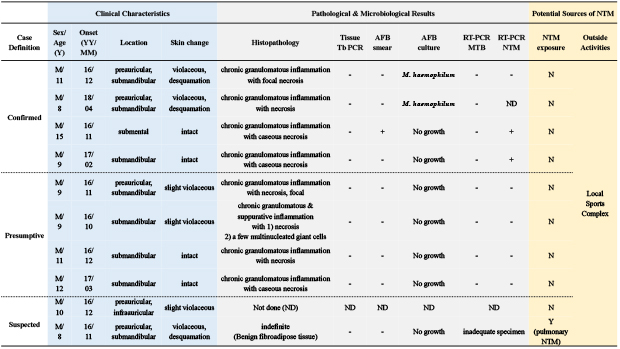1. Zimmermann P, Curtis N, Tebruegge M. Nontuberculous mycobacterial disease in childhood - update on diagnostic approaches and treatment. J Infect. 2017; 74:Suppl 1. S136–S142.
2. Sinagra JL, Kanitz EE, Cerocchi C, Cota C, Fantetti O, Prignano G, et al. Mycobacterium abscessus hand-and-foot disease in children: rare or emerging disease? Pediatr Dermatol. 2014; 31(3):292–297.
3. Griffith DE, Aksamit T, Brown-Elliott BA, Catanzaro A, Daley C, Gordin F, et al. An official ATS/IDSA statement: diagnosis, treatment, and prevention of nontuberculous mycobacterial diseases. Am J Respir Crit Care Med. 2007; 175(4):367–416.
4. Winthrop KL, Abrams M, Yakrus M, Schwartz I, Ely J, Gillies D, et al. An outbreak of mycobacterial furunculosis associated with footbaths at a nail salon. N Engl J Med. 2002; 346(18):1366–1371.
5. Griffin I, Schmitz A, Oliver C, Pritchard S, Zhang G, Rico E, et al. Outbreak of tattoo-associated nontuberculous mycobacterial skin infections. Clin Infect Dis. 2019; 69(6):949–955.
6. Lindeboom JA, Prins JM, Bruijnesteijn van Coppenraet ES, Lindeboom R, Kuijper EJ. Cervicofacial lymphadenitis in children caused by Mycobacterium haemophilum
. Clin Infect Dis. 2005; 41(11):1569–1575.
7. Mandell DL, Wald ER, Michaels MG, Dohar JE. Management of nontuberculous mycobacterial cervical lymphadenitis. Arch Otolaryngol Head Neck Surg. 2003; 129(3):341–344.
8. Kim N, Yi J, Chang CL. Recovery rates of non-tuberculous mycobacteria from clinical specimens are increasing in Korean tertiary-care hospitals. J Korean Med Sci. 2017; 32(8):1263–1267.
9. Kee SJ, Suh SP. Increasing burden of nontuberculous mycobacteria in Korea. J Korean Med Sci. 2017; 32(8):1215–1216.
10. Cohen YH, Amir J, Ashkenazi S, Eidlitz-Markus T, Samra Z, Kaufmann L, et al. Mycobacterium haemophilum and lymphadenitis in immunocompetent children, Israel. Emerg Infect Dis. 2008; 14(9):1437–1439.
11. Zimmermann P, Finn A, Curtis N. Does BCG vaccination protect against nontuberculous mycobacterial infection? A systematic review and meta-analysis. J Infect Dis. 2018; 218(5):679–687.
12. Romanus V, Hallander HO, Wåhlén P, Olinder-Nielsen AM, Magnusson PH, Juhlin I. Atypical mycobacteria in extrapulmonary disease among children. Incidence in Sweden from 1969 to 1990, related to changing BCG-vaccination coverage. Tuber Lung Dis. 1995; 76(4):300–310.
13. Trnka L, Danková D, Svandová E. Six years' experience with the discontinuation of BCG vaccination. 4. Protective effect of BCG vaccination against the Mycobacterium avium intracellulare complex. Tuber Lung Dis. 1994; 75(5):348–352.
14. Katila ML, Brander E, Backman A. Neonatal BCG vaccination and mycobacterial cervical adenitis in childhood. Tubercle. 1987; 68(4):291–296.
15. Kontturi A, Soini H, Ollgren J, Salo E. Increase in childhood nontuberculous mycobacterial infections after Bacille Calmette-Guérin coverage drop: a nationwide, population-based retrospective study, Finland, 1995–2016. Clin Infect Dis. 2018; 67(8):1256–1261.
16. Atiya N, Sulaiman H, Chong J, Ng KP. First report of cervicofacial lymphadenitis due to Mycobacterium haemophilum in an immunocompromised adult patient. J Infect Dev Ctries. 2015; 9(3):313–316.







 PDF
PDF Citation
Citation Print
Print




 XML Download
XML Download